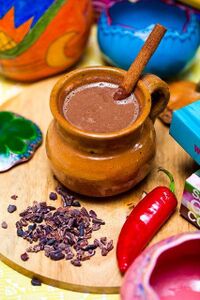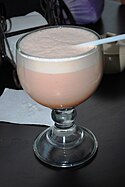Mutulese Chocolate: Difference between revisions
No edit summary |
No edit summary |
||
| Line 27: | Line 27: | ||
Raw chocolate is then sent from the mill to the factory proper. Each factory has its own recipe, many of which are protected by labels and certificates delivered by the [[Divine Throne]]. | Raw chocolate is then sent from the mill to the factory proper. Each factory has its own recipe, many of which are protected by labels and certificates delivered by the [[Divine Throne]]. | ||
===Regional recipes=== | |||
====Muynal==== | |||
[[File:Tejate drink.JPG|125px|thumb|A cup of K'uhb]] | |||
{{wp|Mixtec|Nuu Davi}} and {{wp|Zapotec peoples|Ben Zaa}} people of the [[Yajawil of Muyalkab']] produce a non-alocholic chocolate-maize beverage known as {{wp|Tejate|Cu'uhb}} in Zapotec, and ''K'uhb'' or ''K'ujb'' in [[Mutli]]. Principal ingredients include toasted maize, fermented cacao beans, toasted {{wp|Pouteria sapota|mamey}} pits and {{wp|Quararibea funebris|cacao flower}}. These are finely ground into a paste. The paste is mixed with water, usually by hand, and when it is ready, the flor de cacao rises to the top to form a pasty foam. It can be served as-is or with some sugar syrup to sweeten it. The drink is served cold. | |||
====T'ichan==== | |||
[[File:TaxcalatePalenque.JPG|125px|thumb|right|A glass of 'cacao water' served in Oxchuk]] | |||
Although they are mainly common in the [[Yajawil of T'ichan]] The {{wp|Tzeltal people|Winik Atel}} are present across the middlewest and middlesouth of the Mutul, where the S'amuy valley open on the semi-arid regions of the southeast. There, they produce a beverage known as {{wp|Tascalate|Kakaoeja}} made from a mixture of roasted maize, chocolate, {{wp|Pine nut|ground pine nuts}}, {{wp|achiote}}, {{wp|vanilla}} and {{wp|sugar}}. Ingredients do vary, and it is said that the poorer families' variants are dominated by the taste of roasted corn, while more prestigious and commercial productions are chocolate-dominant in flavour. It's a cold drink, with its ingredients stirred in cold water and often consumed with ice cubes. | |||
====Yokok'ab==== | |||
[[File:Delicioso Popo.jpg|125px|thumb|A bowl of Koko in [[Yu]]]] | |||
In the south of the [[Yajawil of Yokok'ab]], the {{wp|Batz'i K'op|Tzotzil}} produce a ''kakawa'' drink very closely related to the {{wp|Tascalate|Kakaoeja}} of their Winik Atel cousins. But while the recipe is almost identical, an important difference is that they serve it hot: the ingredients, once grounded, are mixed with {{wp|Coconut milk}} and heated. | |||
In the north of the province, the {{wp|Chontal Maya|Yokot'an}} drink a beverage known as {{wp|Popo (Mexican beverage)|Koko}}. is typically made from toasted cacao beans, rice, cinnamon, anise seed and asquiote. The recipe is simple: The rice is left in water to soften. Any fruit added to the drink is to be finely chopped and grounded together with the rice, cinnamon, and anise seeds. The resulting dense pasta is then mixed with water and strained several times with a cotton cloth. Finally, sugar and ice are added, and it is foamed with a wooden grinder. | |||
[[category:Mutul]] | [[category:Mutul]] | ||
[[category:Mutulese culture]] | [[category:Mutulese culture]] | ||
Revision as of 10:19, 11 September 2021
This article is incomplete because it is pending further input from participants, or it is a work-in-progress by one author. Please comment on this article's talk page to share your input, comments and questions. Note: To contribute to this article, you may need to seek help from the author(s) of this page. |

Chocolate, (Mutli: "Kakaw") is produced all throughout the Mutul, in quantities between 9,000 and 20,000 tons of tablets and 9 - 10 millions of bottles per year. The Divine Kingdom is the largest producer of liquid chocolate in the world, and one of the two largest exporters of cacao alongside Sante Reze. Chocolate is almost cosubstantial with the country, as traces of chocolate beverages and vessels associated to its consommation can be found even in the oldest archeological sites. It is supposed that the cultivation of the cacao tree was brought north from the Ucayare forest by nomadic populations of agro-forester. The chocolate produced range from expensive chocolates sold internationally to modest creations usually only seen within the Divine Kingdom.
Two concepts central to the better Mutuleses chocolates are the Nal, which links the style of the chocolate to the locations where the cacao are grown and transformed. The second is the Divine Mark that certifies the origin and the quality of the chocolate. The rules of the attribution of the Divine Mark closely define which cacao varieties and transformation practices are approved for classification in each of the Mutul's 75 000 exploitations. These rules only cover the production and distribution of liquid chocolate, chocolate tablets and "solid chocolate" do not show the same level of regulation, as they are not considered socially to be as prestigious.
History
Early days
Evidence suggest that the cacao tree was first cultivated by humans for its pods' sweet pulp. Fermented, it was served as an alcoholic beverage in the Mutul since 1400 BCE. The first real evidences of the culture of cacao are from Sante Reze, and date back to more than 5000 years ago.
Depiction of offerings of cacao to the gods or to mortal rulers during the Paol'lunyu Dynasty show that it was the kakaw drink that was used for exchanges, not yet to cocoa beans themselves.
Cocoa bean as money
Styles, varieties, and Kakawnal
Kakawnal
The Mutul possess many "Kakawnal", agricultural plantations dedicated to the cultivation of the cacao trees (Mutli: Kakaw T'e). Each has soils, practices, and an history characteristic of the parcel. It's on these specificities that the "Nal" is defined.
For the chocolate industry, the "Nal" refers to the unique combination of natural factors such as soil, underlying rock, altitude, terrain, and microclimate. It is an important factor, alongside the cultivar of chocolate, being measured in the Certification system which guarantees the origin and quality of the production.
varieties
Historically, chocolate makers have recognized three main cultivar groups of cacao beans used to make cocoa and chocolate: Forastero, Criollo and Trinitario. The most prized, rare, and expensive is the Criollo group, the historical cocoa bean of the Mutul. Worldwide, only 10% of chocolate is made from Criollo, which is arguably less bitter and more aromatic than any other bean. In the Mutul, it is up to 80%. Outlying cacao producers who aren't located in the natural biome of the cacao tree still prefer other varieties that are more resistant to diseases and weathers and have higher yields. Since the 2000s, these producers have shifted en-masse to Trinitario, an hybrid between Forastero and Criollo supposed to preserve the qualities of both.
Productions
New processes that speed the production of chocolate emerged early in the Industrial Revolution, which the Mutul never adopted as it retained its traditional preference for chocolate as a drink and not as solid food. As such what comes out of the cacao mills is raw Chocolate liquor, and sometime block of Raw chocolate, for transport.
Raw chocolate is then sent from the mill to the factory proper. Each factory has its own recipe, many of which are protected by labels and certificates delivered by the Divine Throne.
Regional recipes
Muynal
Nuu Davi and Ben Zaa people of the Yajawil of Muyalkab' produce a non-alocholic chocolate-maize beverage known as Cu'uhb in Zapotec, and K'uhb or K'ujb in Mutli. Principal ingredients include toasted maize, fermented cacao beans, toasted mamey pits and cacao flower. These are finely ground into a paste. The paste is mixed with water, usually by hand, and when it is ready, the flor de cacao rises to the top to form a pasty foam. It can be served as-is or with some sugar syrup to sweeten it. The drink is served cold.
T'ichan
Although they are mainly common in the Yajawil of T'ichan The Winik Atel are present across the middlewest and middlesouth of the Mutul, where the S'amuy valley open on the semi-arid regions of the southeast. There, they produce a beverage known as Kakaoeja made from a mixture of roasted maize, chocolate, ground pine nuts, achiote, vanilla and sugar. Ingredients do vary, and it is said that the poorer families' variants are dominated by the taste of roasted corn, while more prestigious and commercial productions are chocolate-dominant in flavour. It's a cold drink, with its ingredients stirred in cold water and often consumed with ice cubes.
Yokok'ab

In the south of the Yajawil of Yokok'ab, the Tzotzil produce a kakawa drink very closely related to the Kakaoeja of their Winik Atel cousins. But while the recipe is almost identical, an important difference is that they serve it hot: the ingredients, once grounded, are mixed with Coconut milk and heated.
In the north of the province, the Yokot'an drink a beverage known as Koko. is typically made from toasted cacao beans, rice, cinnamon, anise seed and asquiote. The recipe is simple: The rice is left in water to soften. Any fruit added to the drink is to be finely chopped and grounded together with the rice, cinnamon, and anise seeds. The resulting dense pasta is then mixed with water and strained several times with a cotton cloth. Finally, sugar and ice are added, and it is foamed with a wooden grinder.

